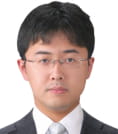- JST Home
- /
- Strategic Basic Research Programs
- /
 PRESTO
PRESTO- /
- project/
- Elucidating mathematical structures in real/virtual world objects and their utilization/
- [Math-Structure] Year Started : 2019
[Math-Structure] Year Started : 2019
Kenta Ishimoto
Mathematical cellular biofluid mechanics and its applications
Researcher
Kenta Ishimoto

Associate Professor
Research Instute for Mathematical Sciences
Kyoto University
Outline
This project aims at new mathematical applications of biofluid mechanics to analyze biological images at the cellular scale by using mathematical structures of the fluid equations which connect ‘flow’ with ‘shape’. Fundamental biological flows, which include internal and external boundary problems, are investigated as an interdisciplinary research, ranging from laboratory experiments and novel data analysis to cutting-edge computational fluid dynamics and explorations for theoretical foundations.
Shunsuke Inenaga
Sequential data analysis with string processing algorithms
Researcher
Shunsuke Inenaga

Associate Professor
Graduate School and Faculty of Information Science and Electrical Engineering
Kyushu University
Outline
Massive digital data, the most of which are semi-automatically generated via M2M communications etc., can be regarded as sequential data or string data. This project aims at developing a platform that offers real-time and secure data processing, which could be implemented into small devices. The key technologies to be used are theory of combinatorics on words, efficient string processing algorithms, security and cryptography.
Ippei Oobayashi
Detection of topological higher structures using persistent homology
Researcher
Ippei Oobayashi

Professor
Cypher-Physical Engineering Informatics Research Core
Okayama University
Outline
The purpose of this research project is the innovation of persistent homology based data analysis. For that purpose, we develop some mathematical components and software components such as machine learning on persistent homology, optimizations on persistent homology, and coarse-grained persistent homology. These components are integrated into a novel framework for the detection of topological higher structures using persistent homology. The key to this research project is the integration of mathematical theory, computer science, and software development.
Shunji Kotsuki
Advancing Data Assimilation and Prediction Methods to Maximize “The Value of Observations”
Researcher
Shunji Kotsuki

Professor
Institute for Advanced Academic Research(IAAR)
Chiba University
Outline
Data assimilation finds the best estimate of the numerical model state based on the observations and model forecasts with their error covariance. Data assimilation, which has been playing an important role in numerical weather prediction, faces challenges to utilize spatially and temporally dense big observation data efficiently. This study advances the data assimilation and prediction methods to maximize “The Value of Observations” through exploring new methodologies that assimilate big data as meta-data such as the value of observations and information features.
Ryota Kobayashi
Modeling event time series by utilizing event information
Researcher
Ryota Kobayashi

Associate Professor
Graduate School of Frontier Sciences
The University of Tokyo
Outline
With the increase of available data, it is becoming increasingly important to utilize time series. Temporal information has not been utilized in most cases because engineers or researchers neglect temporal information when applying machine learning methods. An accurate time series model is necessary for utilizing temporal information. This project focuses on event time series, i.e., the time stamp of an event, including tweets on Twitter, product purchases, and action potentials in the brain. The aim is to develop a methodology for building an accurate time series model that overcomes the difficulties in modeling social and biological systems, e.g., non-stationarity, non-linearity, and partial observability.
Yoshihiko Susuki
Analysis and design of nonlinear dynamical systems using data-driven Koooman operator
Researcher
Yoshihiko Susuki

Associate Professor
Department of Electrical Engineering
Kyoto University
Outline
In order to solve various societal issues such as energy and environment, it is necessary to analyze complex phenomena arising in real-world systems, and at the same time to design a system that has a novel functionality for the solution. This is more common for engineered systems and in the era of data science. In this project, I focus on Koopman operators for nonlinear dynamical systems as a mathematical foundation for the analysis and design, and characterize their spectral properties by techniques from operator theory and theory of functions. I will develop algorithms for estimating the spectral properties directly from data, and thereby establish data-driven methodology for the analysis and design of nonlinear dynamical systems.
Tomohiro Tachi
Creating Structural Origami Patterns Through Self-Organization
Researcher
Tomohiro Tachi

Professor
Graduate School of Arts and Sciences
The University of Tokyo
Outline
In this project, we create novel structural origami patterns that exhibit a wide variety of kinematic behaviors. We build a software system in which the users can interactively manipulate the self-organization processes of patterns; the system helps us to explore the mathematics behind the patterns. We abstract mathematical structures and concepts that bridge spatial forms and structural functions to allow for the design of structural origami patterns, through which we explore applications to science and engineering fields.
Atsushi Nitanda
Efficient Learning Algorithm for Deep Learning based on the Understanding of the Implicit Regularization
Researcher
Atsushi Nitanda

Associate Professor
School of Computer Science and Systems Engineering
Kyushu Institute of Technology
Outline
The goal of this project is to reduce the huge cost for developing deep learning models, resulting in expanding a target domain where these models work well. To do so, I try to unravel the mystery of the implicit regularization ability of successful learning methods. Moreover, I am planning to develop new stable learning methods for the deep learning and network architecture search, which explicitly utilize this regularization ability.
Momoko Hayamizu
Toward a new frontier of computational phylogenetics: a discrete geometric approach
Researcher
Momoko Hayamizu

Associate Professor
Faculty of Science and Engineering
Waseda University
Outline
The problem of extracting graph structures from distances (dissimilarities) appears in data analysis in different scientific disciplines such as the reconstruction of phylogenetic trees or networks from differences between DNA sequences. In this research, we aim to develop novel methods in computational phylogenetics by incorporating various mathematical ideas into the framework of discrete geometric modelling.
Hiroshi Hirai
Algorithm and optimization theory based on novel convexity concepts
Researcher
Hiroshi Hirai

Associate Professor
Graduate School of Information Science and Technology
The University of Tokyo
Outline
Beyond the traditional continious/discrete optimization based on Euclidean convexity, we develop a novel theory for continuous/discrete optimization, computational complexity, and algorithm, based on convexity of metric spaces of nonpositive curvature, such as CAT(0) spaces, and apply it to various areas of mathematics, mathematical science, and information science in an interdisciplinary way.
Yuichi Yoshida
Average Sensitivity Analysis of Optimization Algorithms
Researcher
Yuichi Yoshida

Professor
Principles of Informatics Research Division
National Institute of Informatics
Outline
Optimization algorithms are widely used as tools for decision making and knowledge discovery. In practical applications, however, the given input data may not accurately reflect reality. In this research, we design algorithms with low average sensitivity, that is, algorithms whose output does not greatly change when the input slightly changes at random, so that we can safely use the obtained outputs for subsequent decision making and knowledge discovery.













